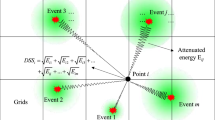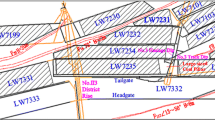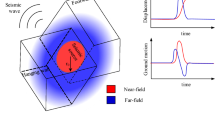Abstract
Mining-induced tremors are indispensable events that gestate and trigger coal bursts. The radiated energy is usually considered a key index to assess coal burst risk of seismic events. This paper presents a model to assess coal burst risk of seismic events based on multiple seismic source parameters. By considering the distribution and relation laws of the seismic source parameters of coal bursts, the model aims to identify dangerous seismic events that more closely match the characteristics of multiple seismic source parameters of coal bursts. The new coal burst risk index T is proposed. It consists of the similarity index SI (representing the similarity degree of relations between seismic events and coal burst events based on seismic source parameters) and the strength index ST (representing the burst strength of seismic events). We studied 79 coal burst events that occurred during extraction in LW250105 of the Huating coal mine in Gansu Province, China. We obtained the distribution and relation laws of multiple seismic source parameters of coal burst events to establish SI and ST. Two groups of seismic events with different energy distributions were examined to compare the assessment results based on the new model and energy criteria. The results show that 80% and 89% of seismic events with strong coal burst risk in Groups A and B, respectively, were coincident, and the seismic events with medium coal burst risk were slightly less compared to those based on radiated energy. The results indicate that the assessment based on the T value is a modification and optimization of that based on radiated energy. This model is conducive to improving the efficiency of monitoring and early warning of coal burst risk.



















Similar content being viewed by others
References
Aki, K., & Richards, P. G. (2002). Quantitative seismology. University Science Books.
Brown, L., & Hudyma, M. (2017). Identification of stress change within a rock mass through apparent stress of local seismic events. Rock Mechanics and Rock Engineering, 50(1), 81–88.
Brune, J. N. (1970). Tectonic stress and the spectra of seismic shear waves from earthquakes. Journal of Geophysical Research, 75(26), 4997–5009.
Cao, A. (2009). Research on seismic effort of burst and failure of coal-rock mass associated with mining and its Application. Dissertation, China University of Mining and Technology. (in Chinese)
Cao, A., Dou, L., Wang, C., Yao, X., Dong, J., & Gu, Y. (2016). Micro-seismic precursory characteristics of rock burst hazard in mining areas near a large residual coal pillar: A case study from Xuzhuang coal mine, Xuzhou, China. Rock Mechanics and Rock Engineering, 49(11), 4407–4422.
Dou, L., Mu, Z., Cao, A., Gong, S., He, H., & Lu, C. (2017). Rockburst prevention and control of coal mine. Science Press. (in Chinese).
Ghosh, G. K., & Sivakumar, C. (2018). Application of underground micro-seismic monitoring for ground failure and secure longwall coal mining operation: A case study in an Indian mine. Journal of Applied Geophysics, 150, 21–39.
He, H., Dou, L., Gong, S., He, J., Zheng, Y., & Zhang, X. (2019a). Micro-seismic and electromagnetic coupling method for coal bump risk assessment based on dynamic static energy principles. Safety Science, 114, 30–39.
He, S., Song, D., Li, Z., He, X., Chen, J., Li, D., & Tian, X. (2019b). Precursor of spatio-temporal evolution law of MS and AE activities for rock burst warning in steeply inclined and extremely thick coal seams under caving mining conditions. Rock Mechanics and Rock Engineering, 52(7), 2415–2435.
Jiang, Y., Pan, Y., Jiang, F., & DOU, L., & Ju, Y. . (2014). State of the art review on mechanism and prevention of coal bumps in China. Journal of China Coal Society, 39(2), 205–213. (in Chinese).
Kornowski, J., & Kurzeja, J. (2012). Prediction of rockburst probability given seismic energy and factors defined by the expert method of hazard evaluation (MRG). Acta Geophysica, 60(2), 472–486.
Li, P. (2016). Study on bursting mechanism of gateways floor and protection methods in Huating coal field. Dissertation, University of Science and Technology Beijing. (in Chinese)
Li, T., Cai, M. F., & Cai, M. (2007). A review of mining-induced seismicity in China. International Journal of Rock Mechanics and Mining Sciences, 44(8), 1149–1171.
Liu, G., Mu, Z., Chen, J., Yang, J., & Cao, J. (2018). Rock burst risk in an island longwall coal face by stress field. Geosciences Journal, 22(4), 609–622.
Ma, C. (2017). Micro-seismic monitoring of brittle fracturing of surrounding rock in deep-buried tunnel and study on interpretation and early-warning of rockburst. Dissertation, Chengdu University of Technology. (in Chinese)
Madariaga, R. (1976). Dynamics of an expanding circular fault. Bulletin of the Seismological Society of America, 66(3), 639–666.
Nordström, E., Dineva, S., & Nordlund, E. (2017). Source parameters of seismic events potentially associated with damage in block 33/34 of the Kiirunavaara mine (Sweden). Acta Geophysica, 65(6), 1229–1242.
Rehbock-Sander, M., & Jesel, T. (2018). Fault induced rock bursts and micro-tremors–Experiences from the Gotthard Base Tunnel. Tunnelling and Underground Space Technology, 81, 358–366.
Shearer, P. M. (2019). Introduction to seismology. Cambridge University Press.
Si, G., Cai, W., Wang, S., & Li, X. (2020). Prediction of relatively high-energy seismic events using spatial–temporal parametrisation of mining-induced seismicity. Rock Mechanics and Rock Engineering, 53(11), 5111–5132.
Šílený, J., & Milev, A. (2006). Seismic moment tensor resolution on a local scale: Simulated rockburst and mine-induced seismic events in the Kopanang gold mine, South Africa. Pure and Applied Geophysics, 163(8), 1495–1513.
Süle, B., & Wéber, Z. (2013). Earthquake source parameters and scaling relationships in Hungary (central Pannonian basin). Journal of Seismology, 17(2), 507–521.
Verdon, J. P., Kendall, J. M., Butcher, A., Luckett, R., & Baptie, B. J. (2018). Seismicity induced by longwall coal mining at the Thoresby Colliery, Nottinghamshire, UK. Geophysical Journal International, 212(2), 942–954.
Wang, C. B., Cao, A. Y., Zhang, C. G., & Canbulat, I. (2020). A New Method to Assess Coal Burst Risks Using Dynamic and Static Loading Analysis. Rock Mechanics and Rock Engineering, 53(3), 1113–1128.
Wang, G., Gong, S., Dou, L., Wang, H., Cai, W., & Cao, A. (2018). Rockburst characteristics in syncline regions and micro-seismic precursors based on energy density clouds. Tunnelling and Underground Space Technology, 81, 83–93.
Whyatt, J., Blake, W., Williams, T., & White, B. (2002). 60 years of rockbursting in the Coeur d’Alene District of Northern Idaho, USA: lessons learned and remaining issues.
Wojtecki, Ł, Konicek, P., Mendecki, M. J., Gołda, I., & Zuberek, W. M. (2020). Geophysical evaluation of effectiveness of blasting for roof caving during longwall mining of coal seam. Pure and Applied Geophysics, 177(2), 905–917.
Wojtecki, Ł, Mendecki, M. J., & Zuberek, W. M. (2017). Determination of de-stress blasting effectiveness using seismic source parameters. Rock Mechanics and Rock Engineering, 50(12), 3233–3244.
Zhang, C., Canbulat, I., Hebblewhite, B., & Ward, C. R. (2017). Assessing coal burst phenomena in mining and insights into directions for future research. International Journal of Coal Geology, 179, 28–44.
Zhao, Y., Yang, T., Yu, Q., & Zhang, P. (2019). Dynamic reduction of rock mass mechanical parameters based on numerical simulation and micro-seismic data–A case study. Tunnelling and Underground Space Technology, 83, 437–451.
Acknowledgments
This research was supported by National Natural Science Foundation of China under Grant Nos. 51734009 and 51674253 and Major Science and Technology Innovation Program of Shandong Province under Grant No. 2019SDZY02. These supports are gratefully acknowledged.
Author information
Authors and Affiliations
Corresponding author
Supplementary Information
Below is the link to the electronic supplementary material.
Rights and permissions
About this article
Cite this article
Chen, F., Cao, A., Liang, Z. et al. A Coal Burst Risk Assessment Model of Seismic Events Based on Multiple Seismic Source Parameters: A Case Study of the Huating Coal Mine, Gansu Province, China. Nat Resour Res 30, 4515–4532 (2021). https://doi.org/10.1007/s11053-021-09938-x
Received:
Accepted:
Published:
Issue Date:
DOI: https://doi.org/10.1007/s11053-021-09938-x




